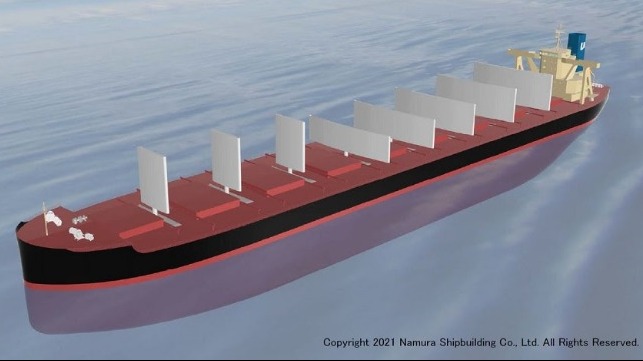Namura & NS United Kaiun in Project to Develop Wind-Assisted Capesize

Japan-based shipbuilder Namura Shipbuilding Co., Ltd. (Osaka, President; Kensuke Namura) and operator NS United Kaiun Kaisha, Ltd (Tokyo, President and Representative Director; Kazuo Tanimizu) have partnered in a joint research project aimed at developing a wind-powered system for a 183,000dwt Capesize bulk carrier.
International ambitions to reduce greenhouse gases (GHG) so as to mitigate climate change have meant numerous targets are being set by international organisations and nation states. The International Maritime Organization’s decarbonisation targets of reducing carbon emissions by 40% by 2030 from 2008’s levels and cut at least 50% of the shipping industry’s total greenhouse gas emissions by 2050 are being exceeded in some cases. As an initiative to reduce GHG at domestic shipyards, the Japanese government has set a target of 46% reduction by 2030 which will require development of new fuel efficient technology.
Namura believes that fuel-efficient technology using wind power will become an indispensable technology in the future. In the joint project with NS United Kaiun, the two partners are aiming to develop fuel-efficient technology using sails to make use of wind power.
Namura has applied for a patent on a sail system in which extending sails are located under deck between the holds of a ship and employed whenever wind conditions are able to aid propulsion and so reduce fuel use.
In use, the sails are elevated above deck and can also be extended laterally to increase the sail surface and hence the propulsion effect. The sails can also be rotated so as to take better advantage of wind direction and gain maximum propulsion effect. When wind conditions are not favourable, or when the ship is conducting cargo operations, the sails are retracted and stored below deck.
The initial intention is to install the system on a 183,000dwt bulk carrier. In order to preserve the SOLAS mandatory line of sight requirements from the bridge on such a long vessel, the size and height of the sails will be optimised. This involves the height of the sails reducing from the wheelhouse towards the bows. Nearer the bows, the height can be increased but the width narrowed allowing vision from the bridge to remain unobstructed.
The products and services herein described in this press release are not endorsed by The Maritime Executive.
